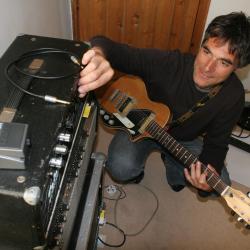Tuning you may wonder, is it not as simple as using your electronic tuner, play string and tune up? Yes but once students have done this I still need to check their guitar to see how well they tuned up. So what is up? Can they not read the tuner? Do they play wrong strings or………….? It is a mix of all those things and usually what it boils down to is not understanding how a guitar responds to a tuner.
First of all let me make the comment: A guitar can not play perfectly in tune. It is due to the nature of the instrument. Not a problem as your ears get accustomed to how the strings sound once they have been tuned up.
The tuning of the guitar does get effected by scale length, fret size, height of action, intonation and how hard you play the strings. It is not my intention to make matters too technical. I only mention some of these issues to make you aware why guitars cannot perfectly play in tune.
Okay let us now go back to the tuning: How do you actually tune your guitar?, what is a good method? Before the invention of electronic tuners (late 70s) you would need to tune to a note from another instrument, like a keyboard, or maybe use a pitchfork—-a metal fork which resonates one note once the fork is lightly touched— Once you have that one note you tune the rest of the guitar to that one note. This system is called Equally Tempered Tuning. Any inefficiencies in your tuning will be divided equally across all your strings and fretboard, this makes up for a more musical tuning and is more pleasing for the ear.
Which one note do you need to tune to? You can choose to tune to your A string, and tune the rest of your strings to the frequency of that note. Personally I like to tune up to the first E string: It is your highest string and tuning up to a high note seems to be easier.
So what do you do?
Step 1: tune the first E string to a tuner or anything which can play the sound of the high E string. Do not play the string as an open string, no do play the harmonic at the 12 fret. Why using a harmonic? Because it is a pure tone. Strings produce overtones, which are a mix of several tones. Your tuner likes to hear a pure tone and pure tones make it easier for the tuner to work correctly.
Step 2: Play the B string at the harmonic of 12th fret and tune this harmonic to the note of the 7th fret on the E string. Once in tune this note will sound the same as the harmonic at the 12th fret of the B string.
Step 3: Play the G string (3rd String) at the harmonic of the 12th fret, and tune this note to the note on the 3rd fret of the E string. Once in tune this note will sound the same as the harmonic at the 12th fret of the G string.
Step 4: Play the D string at the harmonic of the 5th fret and tune this harmonic to the note on the 10th fret on the E string. This note will produce the same note as the harmonic on the 5th fret on the D string.
Step 5: Play the A string at the 5th harmonic and tune this harmonic to the note on the 5th fret on the E string. Once in tune both notes will sound the same.
Step 6: Play the low E string at the 5th harmonic and tune this note to the sound of the first open E string.
Once you have finished all steps you may want to check all the steps again. Do not retune the first E string one you are in the process of tuning the other strings as it will mess up the whole system.
The tuning method I have explained above means you need to tune by ear: The first E string is tuned to a reference note, or an electronic tuner, and all the other notes are tuned by ear to the E string.
Once you have tuned up in this manner you may want to use your tuner to check how your strings will register according to your tuner. What you will find is that some strings may be a little out according to your tuner. This is not because of the tuner is broken, not it is because of the guitar and what I mentioned above about it not being able to be tuned up perfectly.
You can actually use the tuner for the Equally Tempered Tuning as well. You will need a tuner which does have a needle.
Here is how I do this:
Step 1: Play harmonic at 12th fret on first E string and use your tuner to tune up.
Step 2: Play harmonic at 12th fret on B string and use your tuner to tune up. Play the 7th fret on first E string and look at your tuner what it says. It should read the same as when you played the harmonic on the B string. The reading may be slightly different but not too much.
Step 3: Play harmonic at the 12 fret on G string and tune up with your tuner. Play on first string the 3rd fret and see if your tuner gives you the same reading.
Step 4: Here is where this system does not work!! You can tune up harmonic on the 5th fret of the D string, and your tuner should give you a correct tuning, play the 10th fret on the E string and your tuner will give you a reading of being 50 per cent out compared to your previous reading. Once you know this you will be fine and can trust it.
Step 5: Play harmonic at the 5th fret on the A string and use tuner to tune up accordingly, now play on the first E string the 5th fret and your tuner should reading close to what you had before for your A string.
Step 6: Play harmonic on the low E string and use tuner to tune up, check this reading with the open first E string, and your reading may be close. Usually the low E string, when using your tuner, may read a bit sharp, to compensate you can tune a bit lower. Check with your ears to see if your reading sounds like what your read!
Overall using electronic tuners is a good thing, but check them with your ears and try to understand why your hear sometimes different things to what your eyes are reading.
Good luck and hope to see you soon again,
Eddie
 Most people reading this will have dedicated guitar gear like guitaramps and effects such as distortion- and reverb pedals.
Most people reading this will have dedicated guitar gear like guitaramps and effects such as distortion- and reverb pedals.





